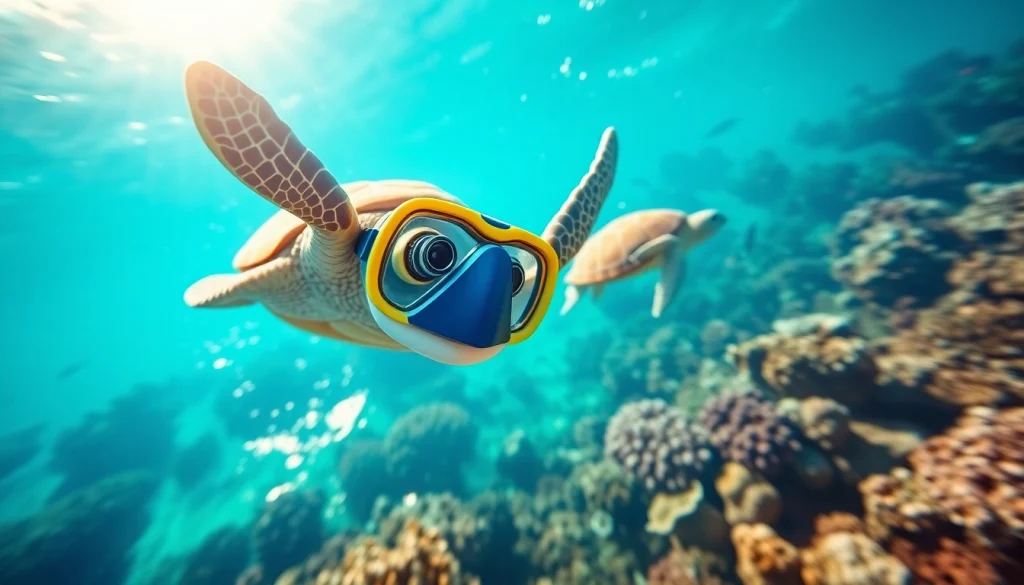Understanding the Turtle Snorkel
What is a Turtle Snorkel?
The turtle snorkel is a specialized snorkel designed to enhance your underwater experience by providing an easy breathing solution while exploring aquatic environments. Unlike traditional snorkels, which can be cumbersome and may involve the need for continuous adjustment, the turtle snorkel is designed for comfort and efficiency. Its unique shape allows for optimal airflow while minimizing water entry, offering snorkelers the chance to focus solely on the marine life around them.
Key Features and Benefits of Turtle Snorkel
Several key features make the turtle snorkel stand out in the market. First and foremost is the design, which is both hydrodynamic and user-friendly. The snorkel typically comes with a splash guard that prevents water from entering the tube when a wave rolls over. This design feature is essential for both safety and comfort, especially for novice snorkelers who may not be accustomed to managing water entry. Furthermore, many turtle snorkels are equipped with purge valves, allowing users to easily clear any water that does enter the snorkel, ensuring uninterrupted breathing.
Another compelling feature is the adjustable mouthpiece, which can be customized for individual comfort, reducing jaw fatigue even during extended underwater adventures. The materials used in the construction of the turtle snorkel are often high-quality silicone and plastic, making them durable yet lightweight. This amalgamation of design and material ensures that snorkelers have a reliable piece of equipment that enhances the overall snorkeling experience.
The Science Behind Snorkeling with a Turtle Snorkel
Understanding the science behind snorkeling aids in maximizing the benefits of using a turtle snorkel. The principle of buoyancy plays a significant role when you are submerged underwater. When a snorkeler breathes using a snorkel, they create a vacuum effect within the snorkel tube, drawing ambient air from the surface. This mechanism enables snorkelers to enjoy breathable air without fully emerging from the water surface, allowing for prolonged explorations.
However, the depth of water can impact this experience; as you go deeper, the pressure increases, which can make breathing more challenging. Thus, the turtle snorkel is beneficial because its design helps to minimize resistance, allowing for a smoother flow of air while counteracting the effects of deep water pressure. This understanding can further guide snorkelers in choosing the appropriate location and depth for their activities.
Choosing Your Snorkel Gear
Essential Equipment for the Best Experience
To ensure an optimal snorkeling experience, one must equip themselves with essential gear that complements the turtle snorkel. Apart from the snorkel itself, a well-fitting snorkel mask is critical. The mask forms a seal around the face, preventing water from entering. When selecting a mask, it’s essential to ensure that it fits snugly while providing a clear line of sight.
In addition to a mask, consider wearing a snorkel vest or buoyancy aid, particularly for inexperienced snorkelers. These vests provide added flotation and confidence in the water. Fins are also a vital component of snorkeling gear. They allow for efficient movement and reduce fatigue, significantly enhancing the overall snorkeling experience.
How to Select the Right Turtle Snorkel
Choosing the right turtle snorkel involves evaluating several criteria, including size, comfort, and functionality. Size is particularly important; selecting a snorkel that fits well enhances comfort, as an ill-fitting snorkel can lead to discomfort around the mouth and jaw. Additionally, seek out snorkels with adjustable elements that allow for a personalized fit.
Consider snorkels with advanced features such as dry tops, which prevent water intake while around the surface. These snorkels ensure that users can maintain a continuous airflow even in choppy waters. Finally, look for models that are lightweight and made of non-toxic materials for enhanced safety and durability.
Comparing Types of Snorkels
When exploring the world of snorkeling equipment, understanding the various types of snorkels is crucial to optimizing your underwater adventures. Generally, snorkels can be categorized into three main types: traditional, dry, and semi-dry. Each type comes with distinct advantages.
Traditional snorkels are straightforward, consisting of a simple tube designed for basic breathability. They are lightweight and often the most affordable, making them a popular choice among beginners. However, they require regular clearing of water, which can interrupt the snorkeling experience.
Dry snorkels are a step up, incorporating features that prevent water from entering the tube. They utilize a buoyant valve that closes when submerged. This design, while more expensive, helps beginners feel safer and requires less maintenance during use.
Semi-dry snorkels combine elements of both traditional and dry snorkels. They typically feature a splash guard that reduces water entry but still isn’t completely airtight. They are a good middle-ground choice for snorkelers seeking both affordability and enhanced performance.
Techniques for Effective Snorkeling with Turtle Snorkel
Proper Breathing Techniques
Mastering proper breathing techniques is essential for a successful snorkeling experience. The key is to remain calm and breathe rhythmically, using your diaphragm rather than your chest to draw air in. This method maximizes oxygen intake and helps maintain a relaxed state while underwater. Practicing deep, steady breaths not only ensures you are adequately oxygenated but also helps stave off feelings of panic in the water.
It is advisable to take slow, measured breaths to conserve energy and avoid hyperventilation. Consistent practice of these techniques can lead to improved comfort while using your turtle snorkel, allowing for longer underwater excursions without fatigue.
Body Positioning and Movement
Effective body positioning can significantly elevate the snorkeling experience. To enhance your comfort and efficiency while swimming, keep your body streamlined. This means lying flat on your stomach with your arms extended in front and your legs slightly apart, which reduces drag in the water. It also allows for easier movement, letting you enjoy the wonder of the underwater world without exhausting yourself.
Using the fins is another essential aspect of movement while snorkeling. Finning should be done discreetly with small, gentle kicks to encourage easy propulsion through the water. Avoid splashing, as this can scare away marine life and disturb the underwater environment. Instead, concentrate on fluid movement, which is not only more efficient but also enhances the overall experience.
Safety Protocols While Snorkeling
Safety should always remain top of mind when snorkeling with the turtle snorkel or any other snorkel gear. Before entering the water, ensure that you’re familiar with the environment and local regulations. Always snorkel with a buddy to keep each other safe and avoid risky situations. A key safety measure is to keep an eye on your surroundings and be aware of currents, waves, and any potential hazards.
Additionally, it’s advisable to maintain an appropriate distance from potential hazards, such as coral reefs and marine life. While exploring, refrain from touching any creatures or plants, as some may be harmful. Always wear a flotation device if you’re not a strong swimmer, and keep a close watch on your energy levels to avoid fatigue and disorientation.
Exploring Marine Life with a Turtle Snorkel
Identifying Common Marine Species
Snorkeling provides an incredible opportunity to encounter various marine species in their natural habitats. Common sights include vibrant coral reefs teeming with life, colorful fish, and occasionally larger marine animals such as sea turtles and rays. Learning to identify these species can enhance your snorkeling experience.
For example, clownfish often inhabit anemones, while parrotfish can be spotted nibbling away on coral. Familiarity with these species enriches your experience and amplifies your appreciation for marine ecosystems. Resources such as field guides and apps dedicated to marine life can be invaluable tools for both novice and experienced snorkelers.
Responsible Wildlife Interaction
Engaging with marine life comes with responsibility. Always remain respectful of the creatures you encounter and their habitats. Avoid touching or attempting to feed marine wildlife, as this can disturb their natural behaviors and put both the animals and snorkelers at risk. Keep your distance to minimize stress on marine species while still observing from a safe vantage point.
If you plan to document your underwater encounters through photography or video, remember to maintain a respectful distance. Using a zoom feature on your camera can help capture stunning shots while minimizing disruption to the environment. Cultivating a mindset of stewardship and respect for the underwater world ensures that these ecosystems can thrive for generations to come.
Best Locations for Turtle Snorkel Adventures
Finding the best locations for turtle snorkel adventures is vital to maximizing your experience. Popular destinations for snorkeling include crystal-clear waters rich with biodiversity. Areas such as the Great Barrier Reef, the Caribbean Islands, and various natural marine parks around the world are top-notch for observing charming marine life. Additionally, many coastal regions offer accessible reefs that can be explored with ease.
Researching local conditions and popular snorkel sites can also provide insight into the best times to visit. Conditions like water temperature, currents, and visibility can all influence your snorkeling experience. Engaging with local snorkeling operators will also supply the latest information on safe spots and prime times for viewing marine life.
Maintaining Your Turtle Snorkel Gear
Cleaning and Care Tips
Proper maintenance of your turtle snorkel gear extends its lifespan and ensures a comfortable experience. After each use, rinse the snorkel and mouthpiece thoroughly with fresh water to remove salt, sand, and debris. Avoid using harsh chemicals, as they can degrade the snorkel’s materials over time.
Regularly check your gear for any wear or damage, particularly the mouthpiece and purge valves, as these areas are more prone to wear. If you notice any cracks or tears, consider replacing those components to maintain optimal performance.
Storing Your Snorkel Equipment
Storing your snorkeling equipment correctly is equally crucial. After cleaning, allow your gear to air dry completely to prevent mold and unpleasant odors. Store the snorkel and mask in a cool, dry place away from direct sunlight to maintain the integrity of the materials.
Many snorkelers opt to use a dedicated gear bag, which not only keeps the equipment organized but also protects it from external elements. Ensure that your bag is spacious enough to accommodate all your gear without causing stress to the components.
When to Replace Turtle Snorkel
Over time, even with proper care, snorkeling gear may reach a point of irreparable wear. Indicators that it might be time to replace your turtle snorkel include persistent leaks, a strained mouthpiece or valves, or visible damage. Regularly assessing the condition of your gear ensures you remain safe while enjoying your underwater adventures.
Additionally, consider upgrading your snorkel as new technology emerges in the field. Advances in materials and design can enhance your overall snorkeling experience, making it worthwhile to stay informed about the latest innovations in snorkeling gear.





